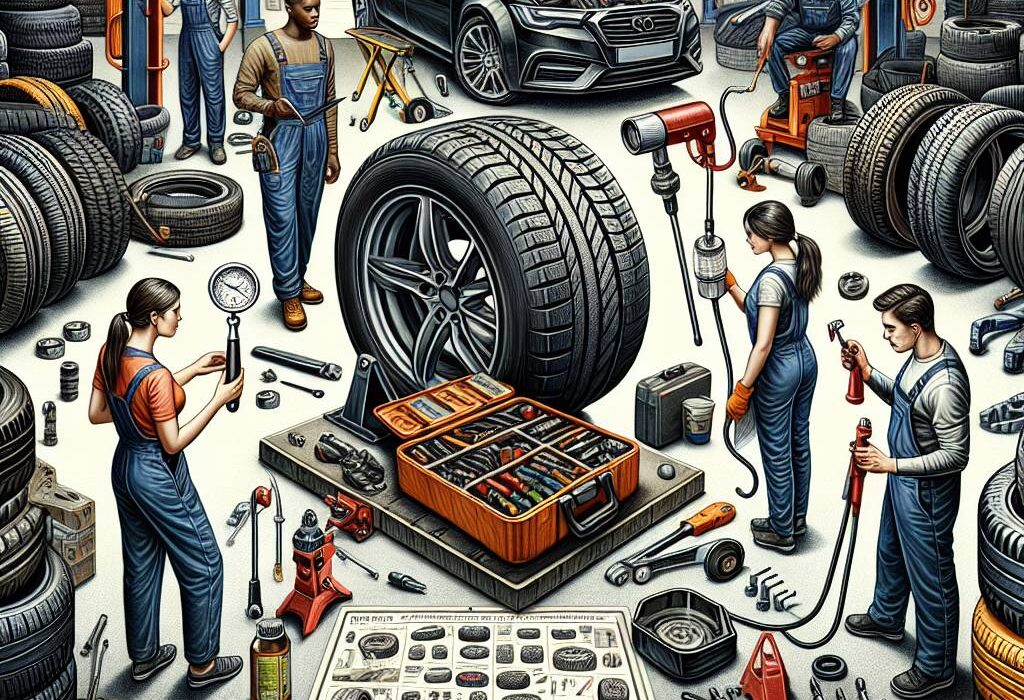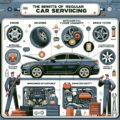Explore essential tire maintenance safety tips, including inspections, pressure checks, and warning signs for optimal vehicle safety and performance.When it comes to vehicle safety, tire maintenance is often overlooked yet plays a crucial role in ensuring a smooth and secure driving experience. Properly maintained tires not only enhance vehicle performance but also significantly reduce the risk of accidents, saving lives and money in the long run. As we delve into the essentials of tire maintenance and safety checks, you’ll discover fundamental practices that can keep you safe on the road. From understanding tire pressure’s critical role to recognizing signs that indicate the need for maintenance, our comprehensive guide will equip you with the knowledge to prioritize your tires’ health. This article provides not only key steps for effective tire maintenance but also insights into the consequences of neglecting this vital aspect of vehicle care. Join us in making your drive safer and more efficient through proactive tire maintenance.
Understanding The Basics Of Tire Maintenance Safety
Ensuring your vehicle’s tires are in top condition is essential for tire maintenance safety. Proper maintenance not only enhances your vehicle’s performance but also safeguards you and your passengers. Here’s a breakdown of the fundamental aspects of maintaining tire safety:
- Regularly Check Tire Pressure: Maintaining the correct tire pressure is crucial. Under-inflated or over-inflated tires can lead to uneven wear and potential blowouts.
- Inspect Tread Depth: Tread depth is vital for traction, especially in wet conditions. Make sure your tires have enough tread to grip the road effectively. Utilize the penny test: insert a penny into the tread with Lincoln’s head facing down; if you can see all of Lincoln’s head, it’s time to replace the tire.
- Rotate Your Tires: Rotating your tires regularly helps ensure even wear, extending the life of your tires and improving safety. Most experts recommend rotating tires every 5,000 to 7,500 miles.
- Check for Damage: Regularly inspect your tires for any visible signs of wear or damage. Look for cracks, bulges, or foreign objects that may have become lodged in the tread.
- Alignment and Balancing: Proper alignment and balance are crucial to achieving optimal tire performance. Misalignment can cause tires to wear unevenly and impact vehicle handling.
These basic practices in tire maintenance safety will go a long way in ensuring not just your safety, but also the longevity and reliability of your vehicle’s tires.
Key Steps In Effective Tire Maintenance For Safety
Ensuring optimal tire maintenance safety is critical for vehicle performance and passenger safety. Here are the key steps you should follow:
- Regular Pressure Checks: Maintaining the correct tire pressure is essential. Use a reliable pressure gauge to check tire pressure at least once a month and before long trips. Adequately inflated tires can improve fuel efficiency and reduce the risk of blowouts.
- Inspect Tread Depth: Check the tread depth regularly to ensure sufficient grip on the road. Insert a penny into the tread; if you can see all of Lincoln’s head, it’s time to replace the tires. Adequate tread depth enhances tire maintenance safety during wet conditions.
- Monitor Wear Patterns: Look for uneven wear on the tires, which may indicate improper alignment or suspension issues. Regularly rotating your tires will help ensure even wear, promoting enhanced durability and safety.
- Check for Damage: Inspect tires for cracks, blisters, or punctures. Even minor damage can lead to bigger problems if not addressed quickly. If you notice any significant damage, consult a professional.
- Ensure Proper Alignment and Balancing: Misaligned or unbalanced tires can lead to uneven wear and affect vehicle handling. Have a professional perform regular alignment and balancing checks during tire rotations.
- Replace Worn Tires: Tire tread wears down over time. If the tread wears down below the legal limit (usually 2/32 inches), it’s essential to replace the tires. New tires ensure maximum traction and safety.
- Store Tires Correctly: If you switch between winter and summer tires, store the off-season tires in a cool, dry place. Keep them upright and avoid stacking them to maintain their shape.
Implementing these steps will significantly enhance tire maintenance safety and contribute to a safer driving experience. Prioritizing tire maintenance not only extends the life of your tires but also ensures your safety on the road.
Regular Inspections: A Vital Input For Tire Safety
Maintaining optimal tire maintenance safety is essential for ensuring the longevity of your tires and, more importantly, the safety of your vehicle. Regular inspections can significantly impact your tire performance and the overall safety of your driving experience. Below are some key points to consider when it comes to conducting regular tire inspections:
- Visual Checks: Regularly inspect your tires for any visible damage such as cuts, punctures, or bulges. Any abnormalities should be addressed immediately.
- Tread Depth: Ensure your tires have adequate tread depth. A quick method to check this is the penny test. Insert a penny into the tread; if you can see Lincoln’s entire head, it’s time to replace your tires.
- Air Pressure Monitoring: Keeping your tires inflated to the manufacturer’s recommended pressure is vital. Under-inflation can lead to uneven wear and increase the risk of a blowout.
- Alignment and Balancing: Ensure that your tires are properly aligned and balanced. Misalignment can lead to uneven tire wear, affecting safety and performance.
- Professional Inspections: While self-checks are useful, having a professional inspect your tires regularly can help identify issues that may not be visible to the untrained eye.
Implementing a routine tire inspection schedule not only enhances tire maintenance safety but also contributes to better fuel efficiency and improved handling. It’s a small effort that can yield significant benefits in terms of safety and performance.
| Inspection Type | Frequency | Action Required |
|---|---|---|
| Visual Check | Every Month | Look for damage |
| Tread Depth Check | Every Six Months | Replace if necessary |
| Pressure Check | Monthly | Inflate to recommended levels |
| Professional Inspection | Annually | Comprehensive checkup |
Signs That Indicate A Need For Tire Maintenance
Recognizing the signs that indicate a need for tire maintenance safety is crucial for ensuring a safe driving experience. Tires can wear down over time and may develop issues that, if not addressed, can lead to significant safety hazards. Here are some key indicators that your tires may require maintenance:
- Low Tread Depth: If the tread on your tires appears worn or is less than 2/32 of an inch, it’s time for replacement. Insufficient tread depth reduces traction and increases the risk of hydroplaning.
- Uneven Wear Patterns: If you notice uneven wear on the tires, it could signal alignment or inflation issues. Consider getting your tires rotated to promote even wear.
- Sidewall Damage: Check for cracks, bulges, or cuts in the sidewalls. Any visible damage should be examined by a professional as it can compromise the tire’s integrity.
- Vibration or Noise: Unusual vibrations or noises while driving may indicate a problem with the tires. This could be a sign of imbalance or a more serious issue.
- Frequent Loss of Air Pressure: If your tires require frequent inflation, it’s a sign of a possible leak or other issues. Consistent pressure levels are essential for tire maintenance safety.
- Dashboard Warning Lights: Pay attention to any warning lights that indicate a tire pressure issue. Ignoring these warnings can lead to tire blowouts.
Timely identification of these signs can prevent accidents and enhance your vehicle’s performance. Always prioritize tire maintenance safety by performing regular checks and addressing any concerns promptly.
The Relationship Between Tire Pressure And Safety
Maintaining proper tire pressure is a critical aspect of tire maintenance safety. Tires that are inflated to the correct pressure provide optimal contact with the road, enhancing traction, steering responsiveness, and overall vehicle handling. On the other hand, either over-inflation or under-inflation can significantly compromise vehicle safety.
Under-inflated tires create excessive flexing and heat build-up, increasing the risk of tire blowouts. Additionally, they can negatively affect fuel efficiency and lead to premature tire wear. Studies show that driving on tires that are 25% below their recommended pressure can reduce fuel efficiency by up to 15%.
Over-inflated tires, while appearing to maintain their shape, can lead to reduced surface contact with the road. This condition can cause uneven tire wear and diminish grip, particularly in wet or slippery conditions. A tire that is too hard may also be prone to damage from potholes and road debris.
To ensure tire maintenance safety, it is advisable to check tire pressure at least once a month and before long trips. Most manufacturers provide recommended tire pressure levels, which can usually be found in the owner’s manual or on a label located on the driver’s side door pillar. Utilizing a reliable pressure gauge will help ensure that tires are at their optimal pressure.
Maintaining the correct tire pressure is essential not only for fuel efficiency but also for your safety on the road. Regular pressure checks are a simple yet effective way to contribute to overall tire maintenance safety, ensuring that your vehicle performs at its best and reduces the risk of accidents caused by tire failure.
The Results Of Neglecting Tire Maintenance Safety
Neglecting tire maintenance safety can lead to a range of serious consequences that not only compromise the safety of the driver and passengers but also affect the overall performance of the vehicle. Here are some key outcomes of ignoring proper tire care:
1. Increased Risk of Accidents: Worn out or improperly inflated tires can lead to reduced traction, increasing the likelihood of skidding, hydroplaning, or losing control of the vehicle, especially in adverse weather conditions.
2. Higher Repair Costs: Failing to maintain your tires can result in collateral damage to other vehicle components, such as suspensions or brakes, leading to expensive repairs that could have been avoided with regular maintenance.
3. Decreased Fuel Efficiency: Tires in poor condition can negatively impact fuel economy, as a vehicle with underinflated tires requires more energy to maintain speed. This results in increased fuel consumption and ultimately, higher operational costs.
4. Shortened Tire Lifespan: Ignoring tire rotation and alignment can result in uneven wear, significantly shortening the lifespan of your tires. This not only increases costs but also compromises safety.
5. Legal Consequences: Depending on the jurisdiction, driving with unsafe tires may lead to fines or penalties and can increase liability in the event of an accident caused by tire failure.
The importance of tire maintenance safety cannot be overstated. Regular maintenance checks can prevent these adverse outcomes and ensure your vehicle operates safely and efficiently on the road.
Frequently Asked Questions
Why is tire maintenance essential for vehicle safety?
Tire maintenance is crucial as it ensures optimal traction, handling, and braking performance. Well-maintained tires reduce the risk of blowouts and accidents.
How often should I check my tire pressure?
It’s recommended to check your tire pressure at least once a month and before long trips to ensure they are inflated to the manufacturer’s specifications.
What can happen if my tires are under-inflated?
Under-inflated tires can lead to increased wear, reduced fuel efficiency, poor handling, and a higher risk of tire blowouts.
How do I know when to replace my tires?
You should replace your tires when the tread depth is less than 2/32 of an inch, when you see visible signs of wear such as cracks or bulges, or when they are over six years old.
What is the importance of regular tire rotations?
Regular tire rotations help ensure even tire wear, extend tire life, and improve vehicle handling and safety.
Can seasonal weather affect tire performance?
Yes, seasonal weather can significantly impact tire performance. Winter tires offer better grip in snow and cold conditions, while summer tires are optimized for warmer, dry roads.
What other maintenance tasks are related to tire safety?
In addition to tire pressure and tread checks, it’s important to inspect the alignment, balance, and wear patterns of your tires, as well as ensuring your brakes are functioning properly.











